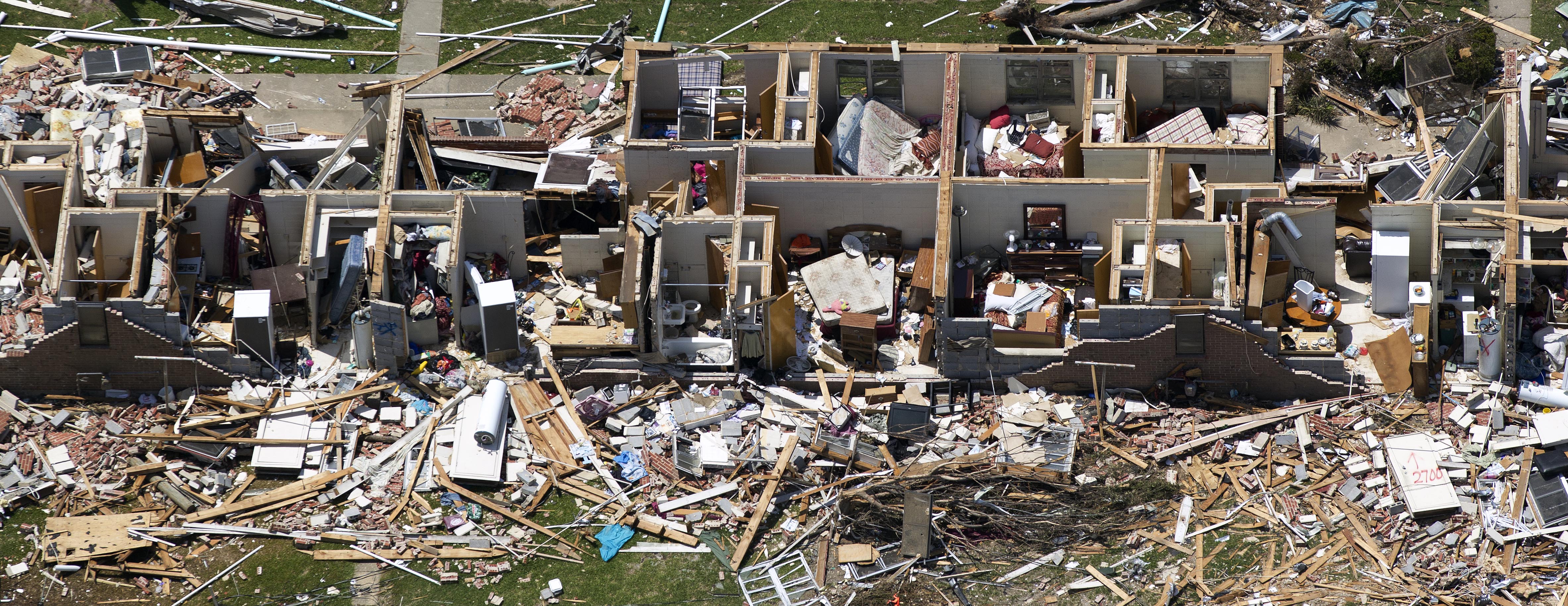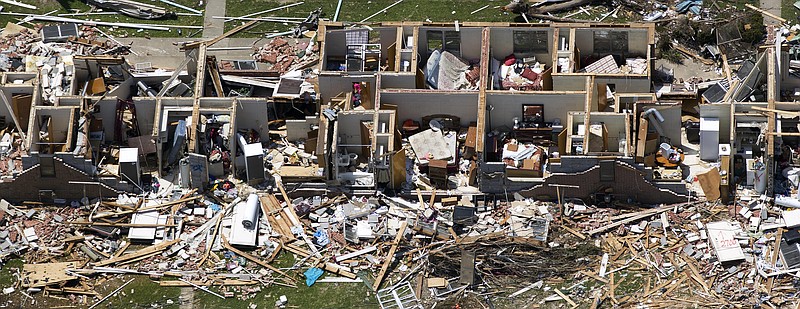 This is an aerial view of damage to Tuscaloosa, Ala., in this photo taken May 7, 2011. Forty-one people were killed in Tuscaloosa and over 200 across the state in tornado strikes last year. Of the 3,228 people statewide who were still in temporary housing provided by the Federal Emergency Management Agency on April 1, more than one-third lived in Tuscaloosa County. Statistics show 1,135 homeowners there remain in temporary housing, or nearly twice as many as far more populous Jefferson County, where 672 people are receiving such aid. Tuscaloosa Mayor Walt Maddox said "Forty percent of the houses destroyed in Alabama were in Tuscaloosa County," "Of those, 61 percent of the 5,362 houses that were destroyed were rentals, and the median income there was $28,000 a household." (AP Photo/Dave Martin, File)
This is an aerial view of damage to Tuscaloosa, Ala., in this photo taken May 7, 2011. Forty-one people were killed in Tuscaloosa and over 200 across the state in tornado strikes last year. Of the 3,228 people statewide who were still in temporary housing provided by the Federal Emergency Management Agency on April 1, more than one-third lived in Tuscaloosa County. Statistics show 1,135 homeowners there remain in temporary housing, or nearly twice as many as far more populous Jefferson County, where 672 people are receiving such aid. Tuscaloosa Mayor Walt Maddox said "Forty percent of the houses destroyed in Alabama were in Tuscaloosa County," "Of those, 61 percent of the 5,362 houses that were destroyed were rentals, and the median income there was $28,000 a household." (AP Photo/Dave Martin, File)MIKE STOBBE
ATLANTA (AP) - Most of the victims of last year's epic tornado outbreak in Alabama had at least one thing in common: They knew the storm was coming.
A year after the onslaught of dozens of twisters killed at least 250 people in Alabama and more elsewhere in the South, federal researchers are completing a study of who died and where they were when it happened. Among the conclusions so far: Nearly half of the people who died had been advised to take shelter. Indeed, most of them did.
But many of the tornadoes were so fierce that few structures were able to withstand them.
"These were catastrophic winds that could destroy pretty much anything in its path," Cindy Chiu, an epidemic intelligence service officer, said in reporting preliminary findings this month at a Centers for Disease Control and Prevention conference in Atlanta.
Unlike in other tornado outbreaks, the largest group of people who died were in single-family houses - not mobile homes - the CDC analysis found.
The April 27, 2011, outbreak involved 62 tornadoes that stretched along ground-hugging tracks that covered more than 1,000 miles. Fatalities were reported from central Alabama to far north Alabama.
While many who heard the warnings sought shelter, others took their chances and lost.
The American Red Cross shares disaster data with the CDC, including what was gathered in extensive interviews with families of the deceased.
Relatives of an 80-year-old woman from Lawrence County "notified her of impending storm - asked her to go to storm shelter next door. She refused, said if her time to go, she would."
The wife of a 35-year-old man from Franklin County heard the warning on TV, according to another vignette provided by Chiu. "She and sons went to basement of neighbors. He stayed in the home," the vignette states. "Tornado struck (at) 330pm and he was found 30 mins later near a tree. He was badly injured and died in the hospital."
The CDC has been examining reports of 255 deaths, including a few for which no Alabama death certificate has been found yet. It's possible a few people were injured in Alabama but died in hospitals in nearby states, Chiu said.
For 120 of those 255, the CDC determined whether the victims knew of the coming tornadoes ahead of time. And 105 were warned.
Of those, 70 took some kind of protective action, like covering themselves or going to what they thought was a safer location or room - including 45 who sought proper shelter, like a basement or interior room on the lowest floor possible. Nineteen were in bathrooms, 10 in basements, 10 in bedrooms and 10 in hallways and smaller numbers in other rooms.
The average age of those who died was 50, and a third of the deaths were people 65 and older, the CDC found.
Being elderly is considered one of the greatest risk factors for death and injury in a tornado. Older people may be less mobile and have more difficulty getting to shelter. They may be frail, and more likely to die from an injury that might not kill a healthier and younger person.
